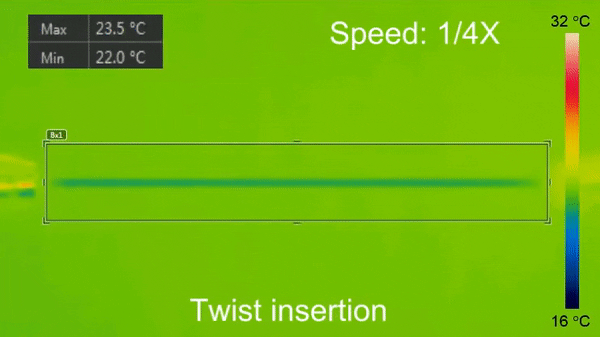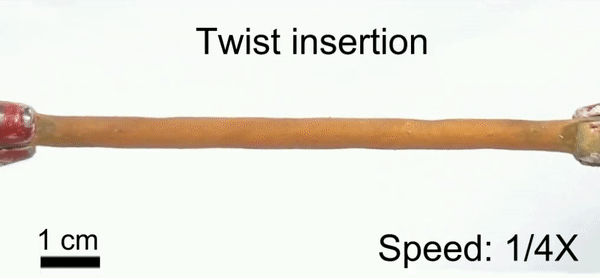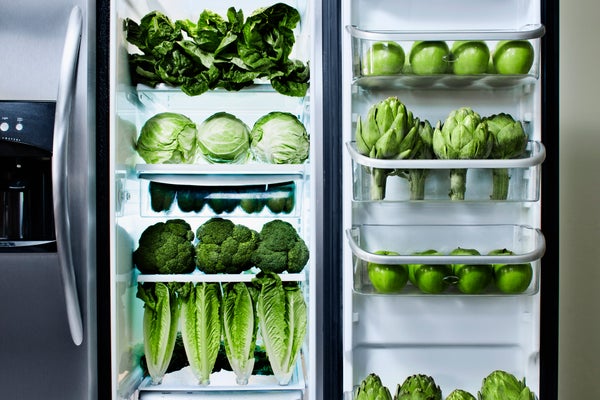Refrigerators are a necessary aspect of modern life, but most of them rely on a cooling mechanism called vapor compression—and the vapors involved tend to be potent greenhouse gases that can contribute to global warming when they escape into the atmosphere. The refrigeration industry has explored ways to improve its environmental impact, such as testing greener gases, but there has been no major shift toward radically new cooling systems. Some scientists, however, are thinking outside the icebox. Researchers have found that mechanically twisting and then releasing certain kinds of fibers can produce so-called twistocaloric cooling, which, they say, could one day lead to more efficient and environmentally-friendly “twist fridges.” Their work was recently published in Science.
“This area of cooling is very hot right now,” says senior author Ray Baughman, director of the Alan G. MacDiarmid NanoTech Institute at the University of Texas at Dallas, who studies artificial muscles made from similar fibers. Twistocaloric cooling relies on the relationship between heat energy and entropy. In general, moving systems tend to become more disordered over time—drop a handful of matches on the floor, and they are much more likely to land in a chaotic jumble than in any orderly array. Neatness can be restored, but someone will have to expend energy in the effort to tidy up.
For another example, picture a rubber band, which is made up of a bundle of fibers. In the early 19th century, researchers found that pulling one makes it feel warmer. This effect happens because stretching the rubber band aligns the fibers more neatly, with less disorder. For this decrease in entropy to occur, the object has to pull in energy, in the form of heat, from its surroundings. When the tension is released, the entropy increases again, and the band cools down.
On supporting science journalism
If you're enjoying this article, consider supporting our award-winning journalism by subscribing. By purchasing a subscription you are helping to ensure the future of impactful stories about the discoveries and ideas shaping our world today.
Although this temperature-changing process has been known for many decades, any practical refrigeration system based on the principle would need to stretch rubber fibers up to six times their original length in order to produce enough cooling. Doing so would require a prohibitively large containment chamber. To achieve the same effect in a smaller space, Baughman thought of twisting the band instead of simply stretching it out.
“If we use twist, we can make a refrigerator [that] has a much smaller volume,” he says. “Inserting the twist doesn’t change the length of the device. But whether we’re stretching a coiled fiber or we are twisting a fiber at constant length, we’re using the same fundamental process—and that is a twist-induced change in entropy.” His team tested the concept with several materials, including a classic rubber band, a fishing line and a nickel-titanium alloy. A thermal camera captured the temperature changes as the fibers twisted and untwisted.

Credit: University of Texas at Dallas
Allowing each of these fibers to quickly untwist produced a cooling effect, but its strength varied, depending on the material. The fishing line, for example, produced only a slight drop in temperature. But the nickel-titanium and rubber achieved a maximum change of more than 16 and nearly 21 degrees Celsius, respectively, Baughman says.
“I think this [study] really opens a very new field for people to look into how to use a mechanical force to generate cooling in very conventional material,” says Qiming Zhang, a materials scientist and electrical engineer at Pennsylvania State University, who was not involved in the new paper.
The researchers also experimented with painting their fibers with heat-responsive dye before twisting and untwisting them, creating a visual signal when the temperature changed.

Credit: University of Texas at Dallas
To achieve as much cooling as possible, the fibers needed more than just a basic twist. With the rubber band, for example, researchers took advantage of the coiling effect: If a string is twisted enough, it will eventually curl into coils. Keep twisting, and the coils will go on to wrap around one another, a state known as supercoiling. In the rubber bands used in the experiment, the big temperature drop came from releasing the coil and thus the twist and stretch.
The nickel-titanium fibers were even more efficient than the rubber bands. To get the greatest temperature change out of this material, Baughman and his colleagues twisted each strand by itself, then twisted all of them as a bundle and released the whole bundle at once. The researchers also built a prototype refrigeration device based on this configuration: They put a three-ply nickel-titanium bundle inside an insulated plastic tube, twisted up that bundle and then ran water through the tube as the bundle untwisted. When the nickel-titanium wires dropped in temperature, they cooled the surrounding liquid by almost eight degrees C. A real twist fridge would, of course, require multiple cycles of twisting and untwisting, which is why Baughman suggests his device could serve simultaneously as a water heater and cooler. Water that would flow over the fibers as they twisted and heated up would be directed toward one reservoir, and liquid flowing over the untwisting and cooling wires would move toward another.
Theoretical models suggest that nickel-titanium could one day achieve a cooling efficiency of about 84 percent, Baughman says—head and shoulders above the 60 percent efficiency of a typical vapor-compression fridge. Like that standard device, a twist fridge would cool its contents by running a chilled coolant fluid through coils surrounding a storage area in order to absorb heat energy. But a conventional fridge requires chemical coolants notorious for contributing to the greenhouse effect. Baughman proposes that the twistocaloric process, with its greater efficiency, could use a lower-impact coolant.
“The vapor compression [systems] really generate a very strong greenhouse gas,” Zhang says. “We have to replace them, because otherwise, we keep getting global warming.”
